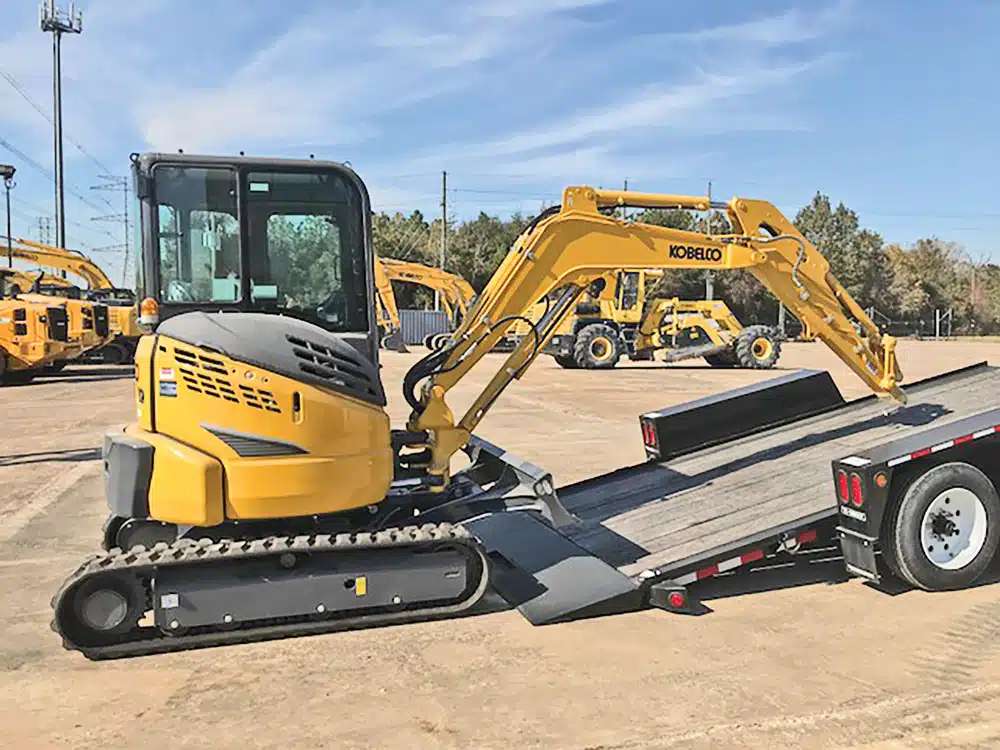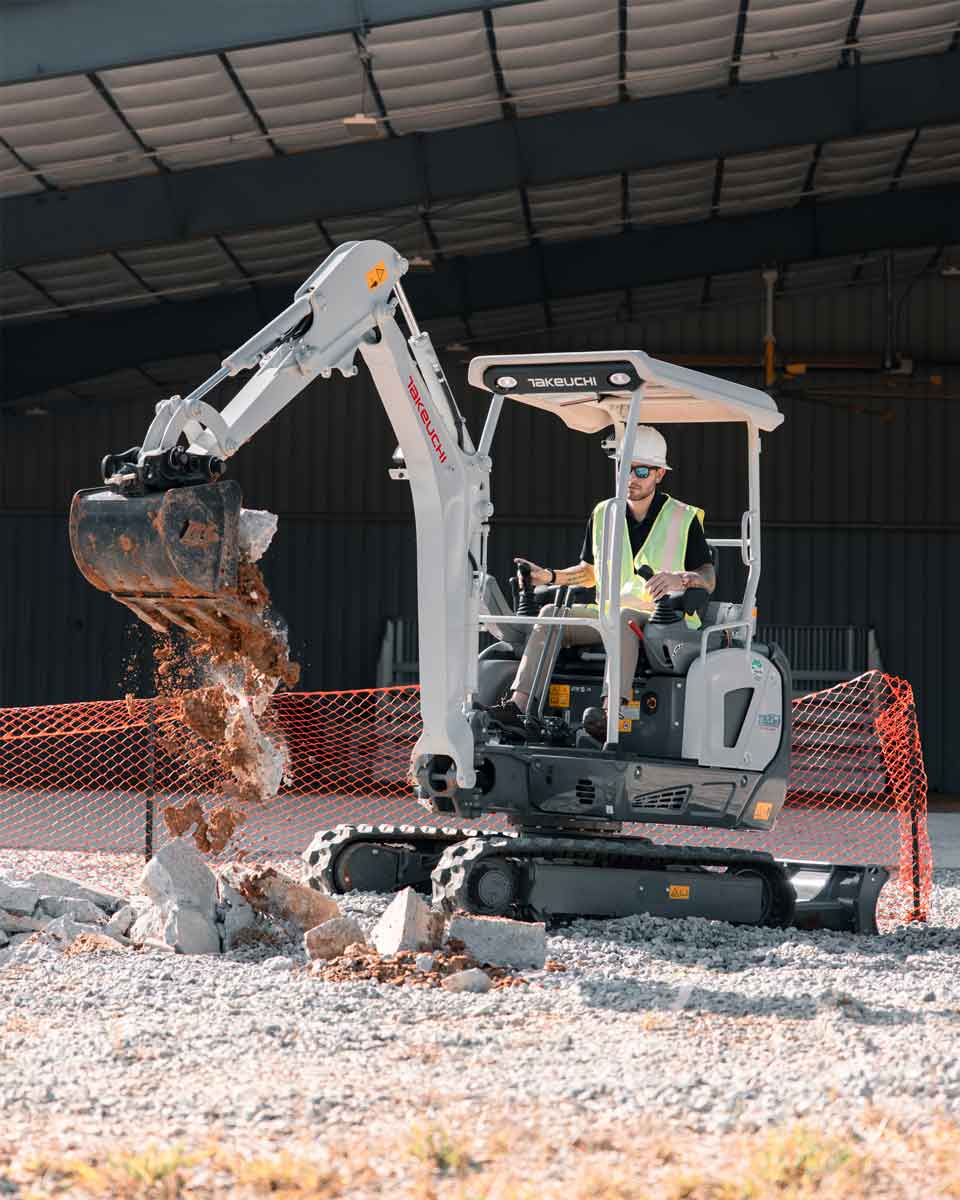Learn the Dos and Don’ts of Trailering Compact Excavators

Whether you’re hauling across a jobsite or from city to city, a lot has to be considered when trailering your compact excavator. It’s not only important that your machinery be transported legally but also safely and securely. Failure to do so can result in overloading the vehicle, causing dangerous situations such as brake failure and tire blows or even being fined. So, what are the proper steps to take when trailering a compact excavator? Here’s what you need to know.
Select the Right Truck and Trailer
To begin, make sure you have a truck that is capable of hauling what you need. Various factors can impact a truck’s towing capacity, such as if it has two-wheel drive or four-wheel drive, two doors or four doors and a gas or diesel engine. Double check that your truck and its trailer hitch meet your maximum capacity requirements. Before selecting a trailer, you must first have a complete understanding of the excavator that you will be hauling. What is the machine’s physical length, width and weight? Will you be hauling anything else with the machine such as an extra bucket, attachments or hand tools?
The total towed weight plus the weight of the trailer must not exceed the trailer’s gross vehicle weight rating (GVWR). GVWR is the maximum weight a trailer is capable of hauling — including the weight of the trailer itself. It is determined by the manufacturer and can be found in the vehicle’s manual. On a bumper pull trailer, the GVWR cannot surpass the trailer’s axle, rim or tire weight ratings, but on a gooseneck trailer it can. A gooseneck hitch allows up to 10 to 20 percent of the total towed weight to be moved to the truck, rather than the trailer. Although this enables you to carry a heavier load, the posted GVWR still must not be exceeded. Overloading is not only unsafe, but it can result in fines. If you are unsure of what size trailer fits your needs, contact your state DOT or trailer manufacturer.
Now that you have a truck and trailer, you need to consider if a commercial driver’s license (CDL) is required. Gross combined weight rating (GCWR) is the total of your truck’s GVWR plus the trailer’s GVWR. If this combined amount exceeds 26,001 lbs, then you must have a CDL. A CDL is still required even if you are driving the truck and trailer empty because of what the vehicle is legally capable of hauling. Know the local laws and regulations in your area. Although they may be similar from state-to-state, there may also be differences. And remember, these laws are in place for everyone’s safety, so ignorance is no excuse.
Arrange Your Trailer for Travel
Now you’re ready to attach your truck and trailer for transportation. Follow these steps to ensure they are put together safely and securely:
- Attach the trailer to the tow vehicle and raise the trailer jack as high as possible to avoid any chance of it hitting the ground.
- Engage the hitch coupler locking mechanism and insert the safety pin or lock into the coupler.
- Attach the trailer safety chains to the frame or hitch of the tow vehicle and crisscross them underneath the coupler. Doing so will allow the safety chains to hold the tongue above the road if the trailer coupler fails. Provide enough slack to allow turns but not enough to drag.
- Connect the electrical harness from the trailer to the tow vehicle and ensure all running lights, turn signals and brake lights are in working order.
- Attach and test the trailer’s electric breakaway system. If the hitch coupler fails, the safety chains will keep the trailer attached to the tow vehicle and the electric breakaway system will apply the trailer brakes, bringing the vehicle to a controlled stop.
Load Your Compact Excavator
Now that you and your vehicle are ready to go, it’s time to load up your mini excavator. Park in a safe area that does not obstruct the view of other drivers or pedestrians and make sure the trailer is attached to the truck at all times. Loading a trailer that is not attached can cause it to move or tip when driving the excavator up the ramps. Furthermore, using ramps with legs, blocks or stabilizers will help prevent the truck and trailer from lifting while the excavator is loaded.
Loading
- Lower the ramps and position the excavator behind the trailer with the dozer blade, boom and arm facing the trailer.
- Drive forward and position the machine with its center line just past the center of the trailer’s axles.
- Rotate the upper carriage of the machine, so it is facing rearward. Lower the blade and boom until the blade and bucket are sitting on the deck of the trailer.
- Turn the excavator off and get out. Look at the truck and trailer to make sure both are sitting level.
The truck should be carrying 10 to 15 percent of the load for a bumper pull trailer and 20 to 25 percent of the load for a gooseneck trailer. The load should be adjusted as required until it is correctly balanced. If too much weight is put forward on the trailer, then the front wheels of the truck may become too lightly loaded and cause loss of steering. And if too much weight is put on the back, the rear wheels of the truck may lift and cause loss of traction and control or become unstable at high speeds.
Securing
- Use four chains and load binders to secure each corner of the compact excavator to the specified points on the track frame.
- Secure the dozer blade to the trailer D-rings and/or DOT specified locations.
- Use a chain or strap to secure the bucket and any other loose items to the trailer.
- Raise and secure the ramps.

Final Check Points
Test the electric brakes with the controller in the cab of the truck to ensure they are adjusted and working properly with the weight of the trailer. To test the trailer brakes, drive at 5 mph and manually apply the electric brake controller in the tow vehicle. You should feel the trailer brakes apply and slow the vehicle. Too much brake will cause the vehicle to jerk and stop. Adjust as required.
Do a final walk around of the truck and trailer to ensure that all lights are working, the hitch coupling device is secure and all safety devices are intact. Check the tires, lug nuts, chains and straps to ensure everything is tight and locked, including all doors and panels on the machine. Once you are confident everything is correct and safe, proceed down the road.
Additional Tips and Tricks
- Using a trailer with a tilt deck instead of ramps makes it easier and quicker to load and unload.
- Trailers with rubber-mounted torsion axles, rather than slipper springs, provide a quieter and smoother ride.
- Keep the machine and trailer clean of mud, dirt and debris as it can fly off and hit other vehicles, or utilize a dump trailer to keep debris contained while hauling.
- If the exhaust pipe of the excavator engine is facing forward, apply duct tape over it to avoid road debris from entering the engine.
David Donneral is the specialized machinery sales manager for Kobelco USA.




